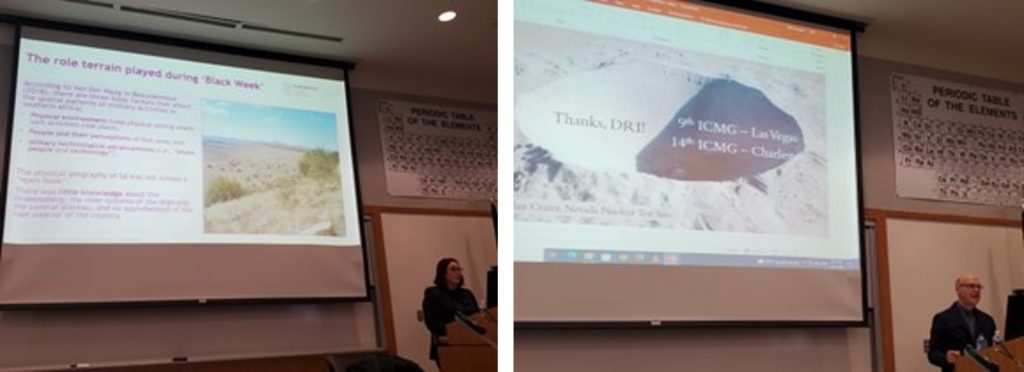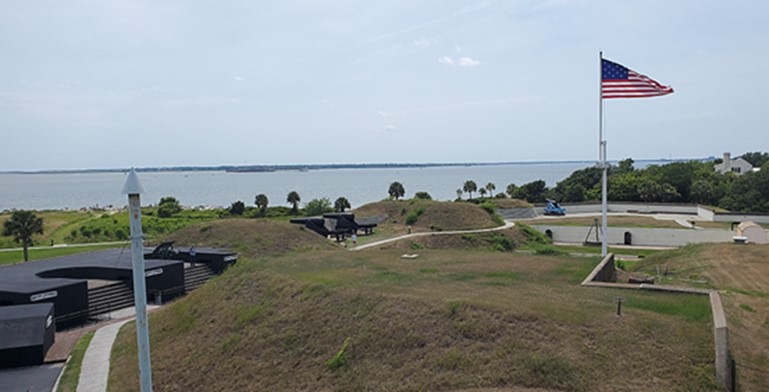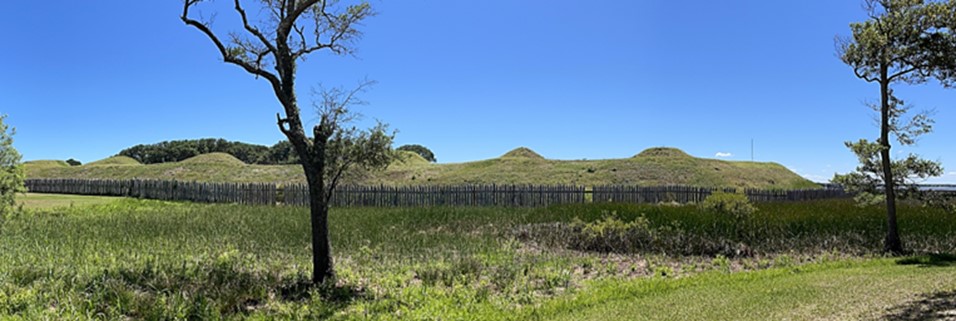The 14th International Conference on Military Geosciences (ICMG) was hosted in Charleston, South Carolina, United States of America.
Theme: Military Geosciences in the 21st Century: Past Lessons and Modern Challenges

The conference theme was a general extension of the theme of the 11th ICMG: Desert Warfare – Past Lessons and Modern Challenges (held in Las Vegas, Nevada 2011, hosted by the Desert Research Institute), expanded to include all terrain and environmental conditions and related impact of historical through modern military operations and environmental and societal challenges.
The conference committee responsible for organizing the conference included: Prof Eric McDonald (Desert Research Institute), Dr. Brad Sion (Desert Research Institute), Prof Steve Henderson (Emeritus, Oxford College, Emory University), Prof Tim Callahan (Chair: Geology and Environmental Geosciences, College of Charleston), and John Eylander (U.S. Army Engineer Research and Development Center).
The original announcement for this conference can be viewed at: http://militarygeoscience.org/conference-2022. Reporting below courtesy of Prof Eric McDonald and the conference team.
Report on the 14th International Conference on Military Geosciences, Charleston, South Carolina, United States of America
The 14th ICMG was held in 2022 from Monday June 20 to Friday 24. The conference presentations were held on the Campus of the College of Charleston, Charleston, South Carolina. Delegates attending the conference were from: Angola, Austria, Germany, Israel, Italy Nigeria, Portugal, South Africa, United Kingdom, and the United States.
The Conference was organized on behalf of the International Association for the Military Geosciences by the Integrated Terrain Analysis Program (ITAP), Desert Research Institute (DRI; Reno, Nevada, U.S.), and the Department of Geology and Environmental Geosciences, College of Charleston. The College of Charleston was founded in 1770 and is the 13th oldest institution of higher learning in the United States. The Conference headquarters was in the historic Francis Marion Hotel (named for Revolutionary War hero Francis Marion, known as the “Swamp Fox”), located near the College of Charleston. Both the College and the hotel are located within the historic area of Charleston known as the ‘Peninsular’. This area of Charleston dates from about 1670 and was a prominent location of military activities from its foundation as well as excellent example of city architecture ranging from the Colonial through the Reconstruction era, and into the Postbellum era (~1670-1945).
A post-conference field Trip was organized from Friday 24 June to Wednesday June 29, 2020, with activities starting in Charleston, SC and concluding in Alexandria, VA. Field trip locations included visits to a range of historical sites including battlefields, museums, forts, and WWII-era ships. Field trip stops encompassed U.S. military activities from the American Revolutionary War (War of Independence) through recent U.S. military engagements.
The Committee graciously acknowledges the important support of DRI faculty and staff who were a tremendous help in organizing the 14th ICMG. Connie Taylor (who also gave a presentation) in tracking most of the critical organizing activities (abstract submittals, expenses, catering, etc., lodging, etc.,). Sally Houseman (with poster contribution) who developed and maintained the 14th ICMG website. Kristine Lu who assisted in a range of organizing activities. Kathryn “Kitty” Henderson who captured photographically many conference moments.
The Committee graciously acknowledges the important support of DRI faculty and staff who were a tremendous help in organizing the 14th ICMG. Connie Taylor (who also gave a presentation) in tracking most of the critical organizing activities (abstract submittals, expenses, catering, etc., lodging, etc.,). Sally Houseman (with poster contribution) who developed and maintained the 14th ICMG website. Kristine Lu who assisted in a range of organizing activities. Kathryn “Kitty” Henderson who captured photographically many conference moments.
Summary of Conference Activities:
Sunday, 19 June: A welcoming reception was held Sunday evening at the Francis Marion Hotel. The venue provided a relaxing opportunity for delegates and accompanying visitors to meet old acquaintances and mak e new ones prior to the start of the academic program.
Monday, June 20: The conference was opened by welcoming introductions from the conference Committee including Professor Tim Callahan (Chair: Geology and Environmental Geosciences, College of Charleston), Professor Eric McDonald (Director ITAP, Earth and Environmental Sciences, DRI), Assistant Professor Brad Sion (DRI), and Professor Steve Henderson (Emory university, and the President International Association for Military: Professor (Cdr) Hennie Smit (Military Geography, Stellenbosch University).

The theme of the morning session, chaired by Peter Guth (Department of Oceanography, United States Naval Academy), was Environmental and Climate Implications for Military Operations. The afternoon session was chaired by Hennie Smit (Department of Military Geography, Faculty of Military Science, Stellenbosch University, President of the IAMG) and with the theme of Military Geoscience: Subsurface Environments. A Poster session concluded the academic program of the first day. Monday evening, delegates enjoyed a hosted dinner at the Francis Marion Hotel which featured examples of local Charleston cuisine.
Tuesday, June 21: Tuesday’s program began with a morning session chaired by Peter Doyle (School of Law & Social Sciences, London South Bank University), with a session theme of Geography and Military History. A short early afternoon session, chaired by Maria Stevens (Coastal and Hydraulics Laboratory, US Army Engineer Research and Development Center), was centered on the theme: Engineering and Vehicle Mobility: Cold Regions. The afternoon included a field excursion to Sullivan’s Island (a barrier island lying east and across the harbor from the Charleston Peninsular) with a tour of Fort Moultrie National Historical Park. Fort Moultrie continuously protected the northern entrance into Charleston Harbor from 1776 until 1946 and provides a wide-ranging example of 19th to 20th century coastal defense fortifications and associated defense weapons.


Wednesday, June 22: Wednesday was a full-day excursion around the Charleston Harbor. The morning featured a ferry-ride to renowned Fort Sumter, where the U.S. Civil War officially began April 12, 1861. The ferry route provided excellent views of the coastal topography, including the southeast coast of the Charleston Peninsula Sullivan’s Island (Tuesdays field trip location), James Island, and Castle Pinckney (harbor fortification built 1810 and used in the Civil War). Fort Sumter is one of over 40 coastal fortifications built by the U.S. Army Corps of Engineers following the War of 1812. The fort was built on a man-made island built on top of a shallow reef and is currently threatened with sea-level rise. Stabilization efforts currently being conducted by the U.S. Army Corps of Engineers underway to protect the fort structure and foundation. The fort was largely destroyed during the Civil War and has been partially rebuilt (e.g. reduced from three stories to one). The current fort still provides an example of the type of fortifications and defensive cannons used prior to the Civil War. Moreover, the central harbor location of Fort Sumter between the nearby defensive positions Fort Moultrie and those on Morris and James Islands highlight the challenge and opportunities of defending a crucial harbor surrounded by lowlands and a harbor with commonly constricted entrance.


The afternoon part of the field excursion began with the delegates enjoying a hosted lunch at the Charleston Harbor Fish House, located on Patriots Point. The lunch featured examples of southern seafood cuisine. After lunch, the delegates had a guided tour of the USS Yorktown (CV-10), the second Excess Class aircraft carrier built during WW II. The USS Yorktown participated in many of the crucial WW II Pacific Campaign battles with service extended into the Korean and Vietnam wars. The tour included a range of static displays of weapons, aircraft, and ship functions and activities when the ship was in active status. Delegates also visited the USS Laffey (DD-724), a WWII Allen Sumner class destroyer with service extended into the Korean and Vietnam wars. Most delegates returned to the Francis Marion Hotel via Charleston Water Taxi that provided a pleasant crossing of the harbor. Delegates were on their own for dinner with an opportunity to enjoy one of many excellent local restaurants.







Thursday, June 23: Tuesday’s program began with a morning session, chaired by Aldino Bondesan (University of Padova, Department of Historical and Geographical Sciences, and the Ancient World), with a session theme of Geography and Military History 2. A short early afternoon session on Military Operations: Modern Challenges was chaired by Jacques Bezuidenhout (Faculty of Military Science, Stellenbosch University, South Africa). The afternoon included a field excursion to James and Folly Islands that are due south of Charleston. The first stop was on James Island at the Civil War site of Battery Lamar, a Confederate battery strong-point built across a narrow isthmus protecting Secessionville and direct land access to nearby Fort Wagner. Fort Wagner (now underwater due to coastal retreat) was a key Confederate position covering Charleston Harbor and the site of a critical Federal assault in July 1863 (this battle is portrayed in the 1989 movie ‘Glory’). The second stop was a hike out to the northern end of Foley Island. The location provides a great view of the Morris Lighthouse which is an excellent example of rapid coastal retreat that us an ongoing process common to barrier islands along the east coast of the U.S. The lighthouse now lies ~ 1km offshore along the current Morris Island shoreline. The current ‘marooned’ position of lighthouse when originally built in 1767 was ~1 km inland. The conclusion of the field excursion included a hosted dinner at the Holy City Brewery in North Charleston where many of the delegates enjoyed excellent examples of local fermented beverages and good pub fare.
Friday, June 23: Friday’s program began with a morning session chaired by Evan Hartshorn (Earth and Ecosystem Sciences, Desert Research Institute), with a session theme of Geospatial Analysis and Applications. A short early afternoon session, chaired by Jennifer Keihofer (Earth and Ecosystem Sciences, Desert Research Institute), was centered on the theme: Engineering and Vehicle Mobility: Terrain Analysis. The afternoon session was concluded with the IAMG Biennial General Meeting, chaired by the President of the Association, Hennie Smit. At the General Meeting, Drew Craig was re-elected as Secretary, Eric McDonald was elected as President.
The ICMG meeting concluded at about 3 pm with most delegates departing Charleston and 9 delegates departing at 4pm on the post-conference field excursion.
Summary of the Post-Conference Field Excursion (June 24-29, 2022)
Charleston, NC to Alexandria, VA.
Guides: E. McDonald, S. Henderson, and B. Sion
Friday 24, 2022: The field excursion traveled north to Conway, SC and enjoyed an outdoor dinner at Dirty Don’s Oyster Bar & Grill in Myrtle Beach, SC. The delegates stayed overnight in Conway, SC.
Saturday 25, 2022: The morning consisted of driving north to Wilmington NC with a lunch at the World-Famous Waffle House (an iconic diner-chain popular across most of the southeast U.S.; MORE). The afternoon included a tour of Fort Fisher, NC, a Civil War fort built by the Confederates between 1861 and 1865. The fort was built to guard the Atlantic entrance to the Cape Fear River and the vital Confederate port of Wilmington. The fort was a well-designed fortification built entirely in sand dunes and consisted almost of re-worked sand. Fort Fisher was the largest Confederate fort, given the nickname the Southern Gibraltar, and was finally captured in February 1865 after an intense sea- and land-attack. Today, only about 10% of the original fort remains due to rising sea-level and extensive erosional retreat of the shoreline. The group overnighted in Wilmington and enjoyed an excellent seafood evening meal at the Steam Restaurant.


Sunday 25, 2022: The morning began with a tour of the WW2 battleship: USS North Carolina (BB-55). The North Carolina was the first of the modern, fast U.S. battleships built after 1922 and was completed and commissioned just prior to the U.S. entry into WW2. The ship was decommissioned soon after WW2 and preserves the original operational design. The tour continued north with lunch at Taqueria Mexicana Angel (Newton Grove, NC). The afternoon tour was a vehicle-audio tour of the Battle of Bentonville that included visits to several key battlefield sites. Bentonville was the last full-scale battle of the Civil War. Much of the battlefield terrain is preserved but is dispersed among active farm fields. The tour continued north with a required stop-over for dinner at Ralph’s Barbecue (established 1952; Weldon, NC) where the group enjoyed authentic North Carolina barbecue (any visit to the Carolinas requires a BBQ meal!). The day’s tour ended with an overnight stop in Roanoke Rapids, NC.


Monday 26, 2022: The morning included a visit to the Petersburg National Battlefield. The Petersburg National Battlefield Park commemorates the ten-month siege of Petersburg from June 1864 to April 1865. The battle of Petersburg pitted the 122,000-man Union Army of the Potomac led by Lieutenant General Ulysses S. Grant against Confederate General Robert E. Lee’s 65,000-man Army of Northern Virginia. An interesting incident of the battle was an unsuccessful attempt by the union to breach the Confederate line through detonation of a large underground mine which resulted in the creation of a large crater, a distinct feature of the battlefield.


As one of the final battles of the war, Petersburg paved the way for Union victory and the Confederate surrender at Appomattox Court House on April 9, 1865. The group enjoyed lunch at the Fat Tuna Grill in Williamsburg. The afternoon consisted of an auto tour of Yorktown Battlefield which included visits to several fortifications and cannons. Yorktown is the site of the last major battle of the Revolutionary War during the fall of 1781. American forces under General George Washington, along with allied American and French forces, besieged General Charles Lord Cornwallis’s British army. Cornwallis surrendered On October 19, effectively ending the war and ensuring independence. The day’s tour ended in Fredericksburg with dinner at Irish Brigade Tavern.

Tuesday 27, 2022: The day began with a morning tour of Fredericksburg Battlefield which included an excellent tour with a National Park Service Ranger with a detailed explanation of the futile Union attack along the Sunken Road. Lunch again at Waffle House in Fredericksburg. The afternoon tour found delegates touring the National Museum of the US Army at Fort Belvoir, VA (~ 10 miles SE of Washington D.C.). The National Museum of the United States Army (recently opened November 11, 2020) is the official museum for the history of the United States Army and contains a large and extensive selection of displays portraying Army history, traditions, and matériel. The group overnighted in historic Colonial Alexandria, VA, and enjoyed a local dinner at The Wharf near the waterfront. The post-conference tour officially ended Tuesday evening.

Wednesday 28, 2022. A few of the delegates optioned for a tour the Manassas National Battlefield Park. The first battle at Manassas (July 21, 1861; also known as Bull Run) was the first time the Confederate and Union armies fought with the battle resulting in a resounding Confederate victory. A second battle was fought at Manassas in August 1862. The afternoon was spent visiting the National Air and Space Museum, Steven F. Udvar-Hazy Center, in Chantilly, VA. This museum is an extension of the popular Air and Space Museum located in Washington D.C. on the Capitol Mall. The Chantilly Air and Space Museum included such iconic aircraft as the WW2 B-29 Enola Gay, a Lockheed SR-71 Blackbird, and an Air France Concorde F-BVFA.

